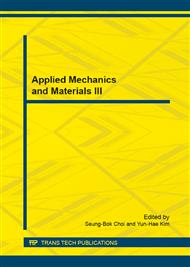[1]
Radford DD, McShane GJ, Deshpande VS, Fleck NA. The response of clamped sandwich plates with metallic foam cores to simulated blast loading [J]. Int J Solids Struct 2006, 43: 2243-2259.
DOI: 10.1016/j.ijsolstr.2005.07.006
Google Scholar
[2]
Arias A, Rodríguez-Martínez JA, Rusinek A. Numerical simulations of impact behaviour of thin steel plates subjected to cylindrical, conical and hemispherical non-deformable projectiles. Eng Fract Mech 2008; 75(6): 1635–56.
DOI: 10.1016/j.engfracmech.2007.06.005
Google Scholar
[3]
BØvik T, Hopperstad OS, Berstad T, Langseth M. Perforation of 12 mm thick steel plates by 20 mm diameter projectiles with flat, hemispherical and conical noses: Part II: numerical simulations. Int J Impact Eng 2002; 27(1): 37–64.
DOI: 10.1016/s0734-743x(01)00035-5
Google Scholar
[4]
BØvik T, Langseth M, Hopperstad OS, Malo KA. Perforation of 12 mm thick steel plates by 20 mm diameter projectiles with flat, hemispherical and conical noses: Part I: experimental study. Int J Impact Eng 2002; 27(1): 1–35.
DOI: 10.1016/s0734-743x(01)00034-3
Google Scholar
[5]
Teng X, Wierzbicki T, Huang M. Ballistic resistance of double-layered armor plates. Int J Impact Eng 2008; 35(8): 870–84.
DOI: 10.1016/j.ijimpeng.2008.01.008
Google Scholar
[6]
Anderson, C.E., Johnson, G.R., Holmquist, T.J. Ballistic Experiments And Computations Of Confined 99. 5% Al2O3 Ceramic Tiles. Proceedings of Fifteenth International Symposium on Ballistics, Jerusalem, Israel, (1995).
Google Scholar
[7]
Han Hui, Li Nan. Research Progress in Metal Encapsulating Ceramic Composite Armors. Ordance material science and engineering. 2008; 31(4): 79-82.
Google Scholar
[8]
McIntosh G. The Johnson–Holmquist ceramic model as used in LS-DYNA 2d. Quebec, Canada: Report of Canada National Defence; (1998).
Google Scholar
[9]
Lopez-Puente J, Arias A, Zaera R, Navarro C. The effect of the thickness of the adhesive layer on the ballistic limit of ceramic/metal armours: an experimental and numerical study. Int J Impact Eng 2005; 32(1): 321-36.
DOI: 10.1016/j.ijimpeng.2005.07.014
Google Scholar
[10]
Borvik T, Dey S, Clausen A H. Perforation resistance of five different high-strength steel plates subjected to small-arms projectiles [J]. Journal of materials Processing Technology, 2009, 36: 948-964.
DOI: 10.1016/j.ijimpeng.2008.12.003
Google Scholar
[11]
Goncalves D P, Demelo F C L, Klein A N. et al. Analysis and investigation of ballistic impact on ceramic/metal composite armour[J]. International Journal of Machine Tools&Manufacture. 2004, 44: 307~316.
DOI: 10.1016/j.ijmachtools.2003.09.005
Google Scholar


